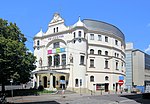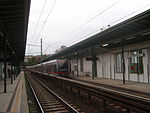The Medical University of Vienna (German: Medizinische Universität Wien) is a public university located in Vienna, Austria. It is the direct successor to the faculty of medicine at the University of Vienna, founded in 1365 by Rudolf IV, Duke of Austria. As one of the oldest medical schools in the world, it is the oldest in the German-speaking countries, and was the second medical faculty in the Holy Roman Empire, after the Charles University of Prague.
The Medical University of Vienna is the largest medical organisation in Austria, as well as one of the top-level research institutions in Europe and provides Europe's largest hospital, the Vienna General Hospital, with all of its medical staff. It consists of 31 university clinics and clinical institutes, and 12 medical-theoretical departments, which perform around 48,000 operations each year. The Vienna General Hospital has about 100,000 patients treated as inpatients and 605,000 treated as outpatients each year.There have been seven Nobel prize laureates affiliated with the medical faculty, and fifteen in total with the University of Vienna. These include Robert Bárány, Julius Wagner-Jauregg and Karl Landsteiner, the discoverer of the ABO blood type system and the Rhesus factor. Sigmund Freud qualified as a doctor at the medical faculty and worked as a doctor and lecturer at the General Hospital, carrying out research into cerebral palsy, aphasia and microscopic neuroanatomy.In the 2014–15 Times Higher Education Rankings, the Medical University of Vienna is listed among the top 15 medical schools in Europe and 49th in the world for category of Clinical, Pre-Clinical and Health.In 2019, there were 8,217 applicants for 660 places in medicine proper and 80 in dentistry, which corresponds to an admission rate of about 9,01% Admission is based upon ranking in an admission test called "MedAT", which is carried out every summer in conjunction with the three other public medical schools of Austria: the Medical University of Graz, the Medical University of Innsbruck and the Medical Faculty at the Johannes Kepler University Linz.









